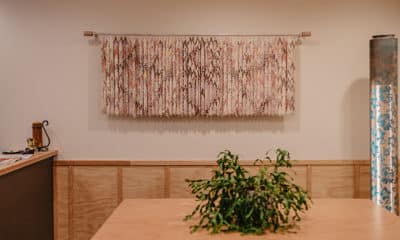IT’S FAIR TO say there’s not a fabric on the market more polarizing than polyester. If you were born before 1985, you probably have a very specific memory associated with the synthetic fiber. I’m willing to bet it was a scratchy, itchy, and sweat-inducing one. Millennials and Gen Z, on the other hand, have no reason to be averse to polyester – active and athleisure brands have been championing it most of their lives.
Polyester has a complicated history and ever-evolving place in the textile food chain. It’s not at the top with the natural fibers like cotton and silk, but it would be unfair to give it the ’70s treatment and push it to the bottom, just because it’s synthetic. The value of polyester is shifting from a strict correlation to production costs to include other factors like sustainability and technical attributes. To complicate things, there are so many types of polyester on the market that understanding modern polyester and how it works can be confusing. A basic Google search on polyester will pull up a variety of opinion articles arguing that polyester suffocates the skin, but that simply isn’t true. At least it doesn’t have to be in 2020.
The pros of polyester currently far outweigh the cons. Modern polyester can be engineered with technical finishes such as moisture management or wicking, which allows moisture to be pulled through the fabric and evaporate. Picture how you feel when you wear your favorite cotton T-shirt to the gym; after a few reps, you’re clammy and your wet shirt is clinging to your skin. It’s never a comfortable situation and it doesn’t have to be that way anymore with the advancements made to polyester. There’s a reason why active and athleisure brands, like Nike and Adidas, are focusing on polyester and positioning it to take over the market – and successfully selling these garments for a pretty penny.
When it comes to your shop or studio, convincing certain apparel and interior designers to embrace polyester can be difficult. I’ve been confronted with this challenge, too, but there are ways to move through it and develop a beautiful, high-quality product your customer loves.
Hype the Technical Advancements
Wicking? Durable water repel? Stain and soil release? These finishes are product and marketing game changers. If your customer is developing an active or athleisure apparel line, suggest a polyester with wicking technology. Your customer will be able to sell the garment at a higher price due to its technical components. (Note: Wicking technology has a laundry list of synonyms, many of which are trademarked. If you come across the terms “moisture-wicking,” “dry-fit,” “cooling,” etc., it’s describing the same technology. Though, finish formulas can differ based on the textile supplier.)
Do you have a customer developing an outerwear or swim line? Suggest a fabric with a durable water repel (DWR) finish. A DWR finish will stop absorption by repelling liquid from the fabric’s surface. This is where your raincoat or boardshort projects come in. If you’re a dye sublimation printer, the best part about DWR is it’s only compatible with dye sublimation printing. Other digital textile printing technologies cannot penetrate the finish. The ability to print on DWR fabrics is an optimal service to highlight, and may end up sparking some new ideas for your customers.
Advertisement
Similar to DWR, stain and soil release finishes are an ideal add-on to upholstery fabrics. If you’re entering the home décor market, be sure to suggest technical polyester fabrics with stain and soil release to your customers. Polyester is continuing to grow in popularity among the interior fabric market, and a technical fabric can give your customers an edge by creating a product with superior durability.
Most DWR and stain and soil release finishes utilize a fluorinated chemistry to achieve their technical results. It’s important to talk to your textile supplier about coating ratings. While long-chain C8 and above ratings may achieve better results, short-chain C6 and below meet Oeko-Tex Standard 100 environmental protection requirements and are being widely adopted by most brands.
Aside from the incredible advancements in finishing technology, there are other exciting developments in the construction of polyesters at mill stage. There are now polyester fabrics on the market that more closely resemble the look and feel of cotton or silk, and they will likely revolutionize the apparel and home markets.
Capitalize on Trends
If you want to add apparel and interior designers to your customer list, understanding current market trends could be your differentiating factor. I like to think about trends as both a language and a connector. Designers look to build on a trend and make it their own. You have the opportunity to meet them halfway by showcasing how you can execute the trend in a new and digital way.
You might be thinking “trend forecasting is the responsibility of the designer,” but I encourage you to reconsider. Every day, more designers are being exposed to digital printing technology. Their wheels are turning in new ways and they have a learning curve ahead of them. When they come to your business in search of partnership, there are aspects of the printing process you’re going to have to teach them. If you’re a dye sublimation shop, you’re going to have to say your process is only compatible with polyester in the first conversation. For some designers, that might be the end of the conversation. In the past, you may have ended it there, too. But if you’re on the forefront of technology trends and can help them break through their preconceived notions of polyester, there’s a good chance they’ll be open to trying dye sublimation.
It doesn’t take a lot of time or money to keep up on trends. It’s as simple as walking through a few stores, like Target or Macy’s, every quarter to see what’s selling. Look at the garment tags (located inside the garment with specific fabric content and manufacturing information) and hang tags (attached to the exterior of the garment with fabric highlights and product marketing). Take note of the fabric content (Polyester? A blend? Cotton?), construction (Jersey knit? Twill? Interlock?), weight, and finish (Wicking? DWR?). It doesn’t hurt to look at colors, texture, and how the fabric is marketed either.
Advertisement
The ability to talk trends is a critical skill. I work it into conversations as much as I can to build the customer’s trust. Their initial concept may revolve around other fibers, but when I can illustrate, for example, that an interlock, wicking polyester fabric with a soft natural hand will not only extend the lifetime of the garment, but also create a superior product while increasing marketability and their selling price, it undoubtedly gives them something to think about.
Embrace the Future: Recycled Polyester
It would be inaccurate to call recycled polyester a trend. It’s a fiber reflecting a shift in cultural values that’s cementing itself as a power player in fashion. Millennials and Gen Z are hungry for it as it continues to become more readily available, cost-effective, and technically advanced.
In the digital textile printing community there has been a debate and some apprehension from printers to utilize this media. If you’re a printer who tested recycled polyester five years ago, you might have had bad results. It’s a story I’ve heard many times, and it’s kept businesses from experimenting with recycled polyester. Poor image clarity and color saturation prompted many to walk away, but it’s time to give it another shot because recycled polyester has evolved in quality and printability.
Recycled polyester isn’t a tough sell; the quality is high, it’s easily marketable, and, most of all, it’s the best option for the planet. There are impressive solutions available to the apparel and signage markets, and recycled polyester for the home market won’t be far behind. Don’t wait to hop on this train; it’s not stopping any time soon.
Starting a New Conversation
Moving forward, more designers and brands are going to come to our industry looking to capitalize on customization and creative solutions. Polyester is often a huge part of this equation and it deserves a second chance. The marketer in me wants to call for a polyester rebrand. I encourage you to continue learning about this fiber as it advances and reconsider the discussion around it. Polyester isn’t just the fabric of the future; it’s the fabric of right now. It might take some mental gymnastics for you and your customers, but the future is bright and it leaves the door wide open for new opportunities.

 Best of Wide Format1 month ago
Best of Wide Format1 month ago
 Columns2 months ago
Columns2 months ago
 Best of Wide Format1 month ago
Best of Wide Format1 month ago
 Best of Wide Format1 month ago
Best of Wide Format1 month ago
 Best of Wide Format1 month ago
Best of Wide Format1 month ago
 Best of Wide Format1 month ago
Best of Wide Format1 month ago
 Blue Print5 days ago
Blue Print5 days ago
 Best of Wide Format1 month ago
Best of Wide Format1 month ago



















